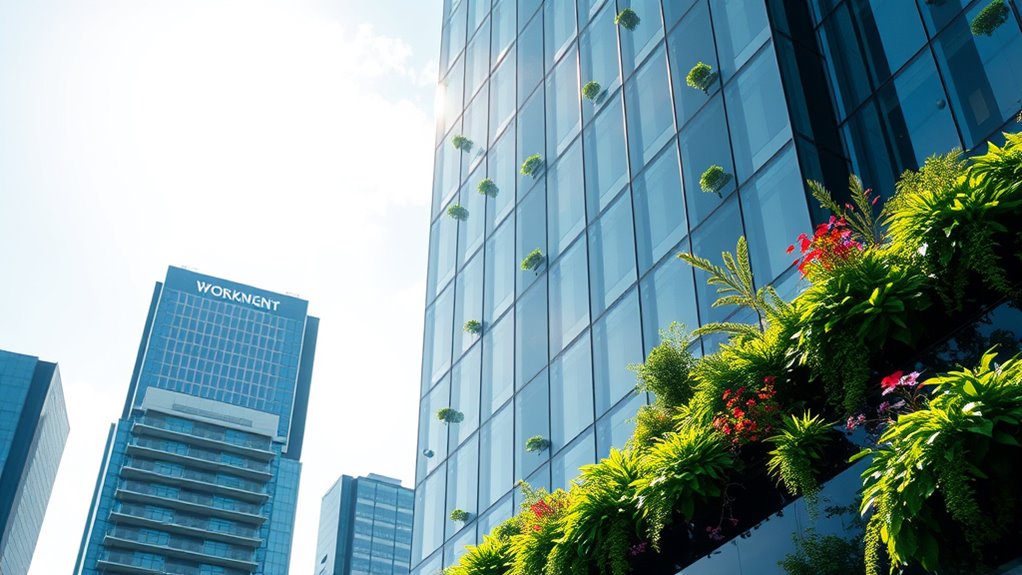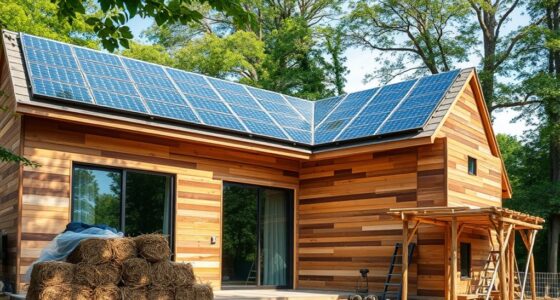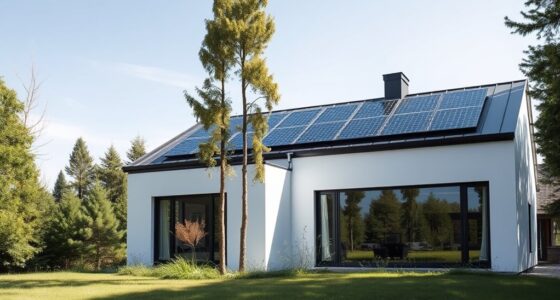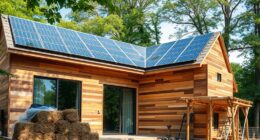Smart green technology leverages IoT to transform buildings into self-sustaining systems. By using energy harvesting, your building can capture ambient power from sunlight, vibrations, or temperature differences, reducing reliance on external power. IoT sensors enable continuous monitoring and predictive maintenance, optimizing energy use and extending equipment life. Automated adjustments in lighting and climate control improve efficiency, making your building more eco-friendly. Explore further to see how these innovations work together to create intelligent, sustainable environments.
Key Takeaways
- IoT integrates sensors and actuators to monitor and optimize building systems, enhancing energy efficiency and occupant comfort.
- Energy harvesting enables autonomous IoT devices, reducing reliance on external power and supporting sustainable building operations.
- Predictive maintenance through IoT sensors detects issues early, minimizing downtime and extending equipment lifespan.
- Smart environmental controls adjust lighting, heating, and cooling dynamically, based on occupancy and natural conditions.
- Combining energy harvesting with IoT creates self-sustaining, eco-friendly buildings that optimize resource use and reduce environmental impact.
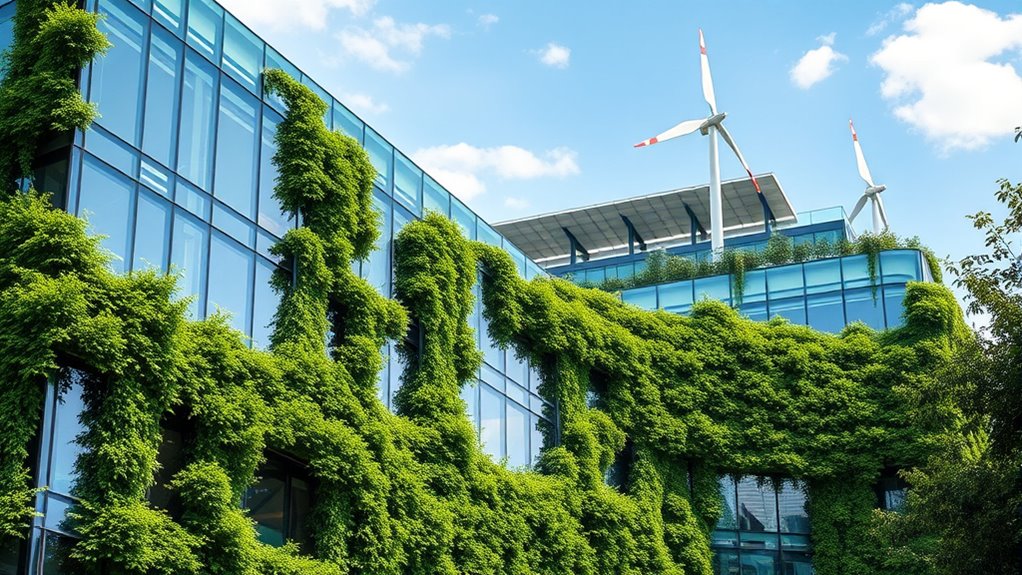
Have you ever wondered how the Internet of Things (IoT) can help protect our environment? Smart buildings powered by IoT are transforming the way we manage energy and resources, making the spaces we live and work in more sustainable. One of the key ways this is happening is through the integration of energy harvesting technologies. Instead of relying solely on traditional power sources, IoT devices can harness ambient energy from sunlight, vibrations, or even temperature differences. This approach reduces the need for external power supplies and minimizes energy waste, making systems more efficient and eco-friendly. By capturing energy from the environment, these devices can operate autonomously for long periods, lowering maintenance costs and decreasing the carbon footprint associated with powering large building networks.
Another essential aspect of IoT-driven smart buildings is predictive maintenance. Traditional maintenance routines often involve scheduled checks or reactive repairs after a system fails, which can lead to unnecessary energy consumption and waste. Predictive maintenance, on the other hand, uses IoT sensors to continuously monitor the condition of equipment like HVAC systems, lighting, and plumbing. These sensors gather real-time data on temperature, vibration, humidity, and other parameters, enabling building managers to anticipate issues before they escalate. As a result, maintenance becomes more targeted and timely, reducing the likelihood of system breakdowns and inefficient operation. This proactive approach not only extends the lifespan of equipment but also conserves energy by ensuring that systems run at their best and only when needed.
Imagine a building that adjusts its heating and cooling based on occupancy patterns detected by IoT sensors, or lighting that dims automatically when natural daylight is sufficient. These smart adjustments are made possible through energy harvesting, which supplies the power needed for sensors and control systems to operate continuously without interruption. The seamless integration of energy harvesting with predictive maintenance creates a self-sustaining environment where systems are always functioning at peak efficiency. This synergy improves overall energy consumption, reduces waste, and enhances the building’s environmental footprint. Additionally, high contrast ratios in projectors can significantly improve visibility and image quality in well-lit spaces, complementing the overall sustainable design of modern smart buildings.
Frequently Asked Questions
How Does Iot Enhance Building Energy Efficiency?
IoT enhances building energy efficiency by enabling advanced building automation and real-time energy analytics. You can optimize lighting, heating, and cooling systems based on occupancy and usage patterns, reducing waste. IoT devices monitor energy consumption continuously, providing insights that help you make smarter decisions. This integration creates a more sustainable building environment, lowering costs, and improving overall efficiency, all while giving you better control over your energy usage.
What Are the Security Risks of Smart Building Systems?
Oh, the irony isn’t lost—your smart building’s convenience could be its downfall. You face cybersecurity vulnerabilities that hackers might exploit, turning your automation into a nightmare. Unauthorized access isn’t just a threat; it’s a reality that could compromise your system’s safety and privacy. So, while IoT makes buildings smarter, it also invites risks that demand vigilant security measures to keep your digital fortress intact.
Can Iot Reduce Maintenance Costs for Buildings?
You can definitely use IoT to reduce building maintenance costs. By implementing predictive maintenance, you’ll catch issues early before they become costly repairs, saving time and money. Plus, IoT enhances occupant comfort by optimizing systems like HVAC and lighting automatically. This proactive approach keeps everything running smoothly, minimizes downtime, and lowers long-term expenses—making your building more efficient and comfortable for everyone.
How Is Data Privacy Managed in Green Iot Applications?
When managing data privacy in green IoT applications, you should implement strong data encryption to protect sensitive information. Additionally, you need clear privacy policies that outline how data is collected, used, and stored. By actively enforcing encryption standards and transparent policies, you guarantee user trust and compliance with regulations, making your green IoT systems safer and more reliable for everyone involved.
What Are the Challenges in Integrating Iot With Existing Infrastructure?
Imagine you’re trying to connect a modern smartphone to a rotary dial phone—it’s like integrating IoT with legacy systems. You face interoperability challenges because outdated infrastructure often lacks compatibility with new devices. This makes seamless communication difficult, requiring extra effort, adapters, or even complete overhauls. Overcoming these hurdles demands careful planning, ensuring your smart systems work harmoniously without disrupting existing operations.
Conclusion
Imagine walking into a building that breathes with you, its walls alive with sensors that adjust to your needs, conserving energy effortlessly. Green IoT transforms structures into vibrant, responsive systems—like a living organism, constantly adapting and thriving. As you witness these smart buildings flourish, you realize you’re part of a future where technology and nature work hand in hand, creating spaces that are not just sustainable but truly alive with innovation.
